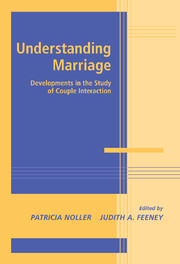Book contents
- Frontmatter
- Contents
- Contribitors
- Introduction
- SECTION ONE THE EFFECT OF COGNITION ON INTERACTION PATTERNS
- SECTION TWO UNDERSTANDING THE IMPORTANCE OF POSITIVE INTERACTION
- SECTION THREE COPING WITH DISAPPOINTMENT, CRITICISM, AND BETRAYAL
- SECTION FOUR POWER, CONFLICT, AND VIOLENCE IN MARITAL INTERACTION
- Marital interaction at important transition periods
- Introduction to Section Five
- 14 Adult Attachment, the Transition to Parenthood, and Marital Well-Being
- 15 Allocation and Performance of Household Tasks: A Comparison of New Parents and Childless Couples
- 16 Care Giving and Its Influence on Marital Interactions between Older Spouses
- SECTION SIX Interventions for strengthening relationships
- Conclusions
- Index
- References
15 - Allocation and Performance of Household Tasks: A Comparison of New Parents and Childless Couples
Published online by Cambridge University Press: 25 July 2009
- Frontmatter
- Contents
- Contribitors
- Introduction
- SECTION ONE THE EFFECT OF COGNITION ON INTERACTION PATTERNS
- SECTION TWO UNDERSTANDING THE IMPORTANCE OF POSITIVE INTERACTION
- SECTION THREE COPING WITH DISAPPOINTMENT, CRITICISM, AND BETRAYAL
- SECTION FOUR POWER, CONFLICT, AND VIOLENCE IN MARITAL INTERACTION
- Marital interaction at important transition periods
- Introduction to Section Five
- 14 Adult Attachment, the Transition to Parenthood, and Marital Well-Being
- 15 Allocation and Performance of Household Tasks: A Comparison of New Parents and Childless Couples
- 16 Care Giving and Its Influence on Marital Interactions between Older Spouses
- SECTION SIX Interventions for strengthening relationships
- Conclusions
- Index
- References
Summary
W: You have to race around and do the housework in between sleeps, and if the baby doesn't sleep during the day–which has happened a lot lately–you get nothing done, and you end up tired and cranky.
H: And then we fight.
W: You take all your frustrations out on each other.
H: Because I work – I work really hard outside. And I come home and I'm just so tired, and she's like ‘I've had this terrible day, and I haven't got any housework done, and I need some sleep,’ and I'm thinking ‘I really don't need this right now.’ And I think, ‘How hard could it be? Like, you just feed him and put him to sleep and then you go and do your stuff.’
Recent decades have seen marked changes in attitudes toward gender roles and in women's involvement in the labor force. Given these changes, it might seem reasonable to assume that families establish much more equitable patterns of domestic work today than they did in the past. Evidence suggests, however, that this is not the case. With the transition to parenthood, in particular, couples often move toward a traditional division of labor, in which women do the bulk of the child care and other household tasks; further, partners do not necessarily see this situation as “unfair.” In fact, perceptions of unfairness are only weakly linked to patterns of task performance, and seem to be shaped by many aspects of individual and couple functioning.
- Type
- Chapter
- Information
- Understanding MarriageDevelopments in the Study of Couple Interaction, pp. 411 - 436Publisher: Cambridge University PressPrint publication year: 2002
References
- 2
- Cited by



